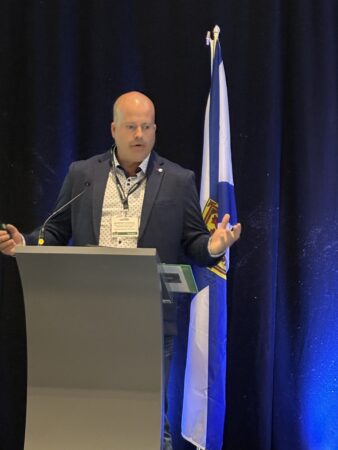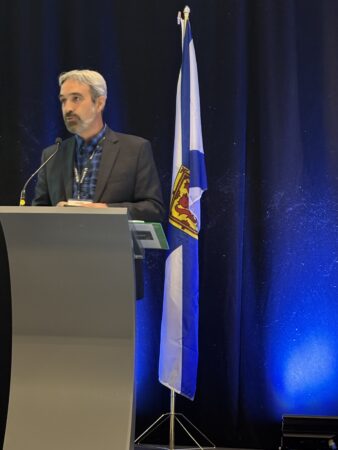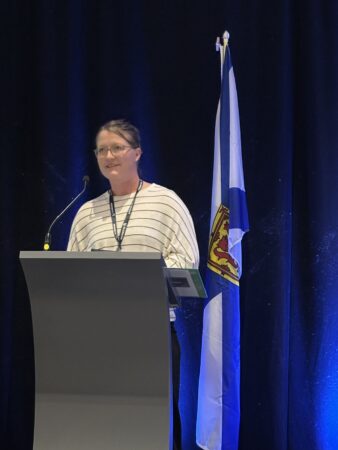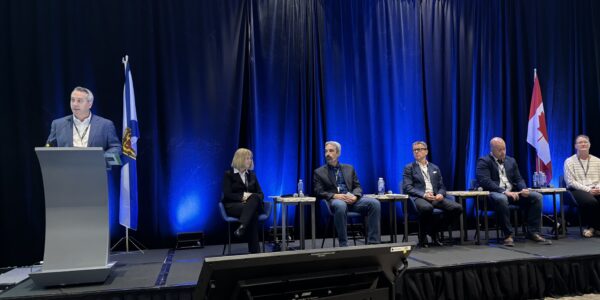Bioheat was a hot topic of discussion during Day 1 of the Wood Pellet Association of Canada’s annual conference taking place from Sept. 23 to 24 in Halifax.
Themed “Biomass for a Low-Carbon Future,” Day 1 of the conference offered attendees a variety of sessions covering safe biomass storage best practices; powering the net-negative transition; decarbonizing industry; bioheat opportunities for Canada; and more.
The “Bioheat Opportunities for Canada” panel discussion showcased projects and initiatives from Atlantic Canada, the Northwest Territories, Sweden and Austria.
The session featured panellists Jonathan Levesque, General Manager of Biomass Solution Biomasse (BSB); Mark Heyck, Executive Director of the Arctic Energy Alliance; Jean Blair, Director of Planning and Outreach at TorchLight Bioresources; Gustav Melin, Chaiman of World Thermal Services in Sweden; and Christiane Egger, Deputy Manager, OÖ Energiesparverband, Austria.
The panel was moderated by Reg Woods, General Manager for Grand River Pellets Limited.

Local projects were the first to be presented with BSB’s Jonathan Levesque discussing a recent biomass boiler installation at Paroisse Notre-Dame-des-Prodiges, a multi-purpose facility and Catholic church in Kedgwick, N.B., which had switched over to wood pellets as its primary source of heat.
The church and its various facilities were being heated with firewood until the individual donating the wood passed away. With no one else in the community donating the firewood to feed the old firewood boiler, the church’s leaders needed to find an alternative source of heat and decided to purchase three oil-fired boilers. At the time, oil was cheap. But once energy prices spiked, the church found itself in a poor position financially.
“That was a bad move because with 38,000 litres to keep those three buildings heated properly, they were pretty desperate in 2024,” Levesque told the crowd.
Fortunately, BSB was able to convince the church’s leadership to swap out the primary oil-fired boiler for a Herz Firematic 150kW biomass boiler fuelled with wood pellets.
“They were paying $60,000 a year for oil, compared to $25,000 for pellets,” Levesque said, explaining that it is estimated that the new system will consume about 80 tonnes of wood pellets annually.
To pay for the installation of the new boiler system, the church performed fundraising activities within the community and took advantage of the NB Power Energy Efficiency Program, which covered 25 per cent of the cost off the installation since they were heating with oil fuel.
Northern opportunities

Mark Heyck of the Arctic Energy Alliance presented next, discussing the adoption of biomass throughout the N.W.T., which has become a champion of biomass use for space heating. The Arctic Energy Alliance is a non-profit that was created in the late 90s by the Government of Northwest Territories as an entity to deliver programs around energy efficiency and renewable energy technologies.
“The idea at the time was to create a non-profit that could be a little more flexible as a public-facing service delivery agency,” Heyck explained. “We’ve grown considerably over the years. We have our headquarters in Yellowknife, but we also have five regional offices through the Northwest Territories, and that allows us to make sure that our programs and services are being equitably delivered to all 33 communities in the Northwest Territories.”
Heyck said that the percentage of houses and buildings on space heating in the territory fuelled by biomass is probably the highest in Canada.
“So, how did we get there? One of our benefits of being a small jurisdiction, population wise, is that as a territory, despite our vast geography, we’re 43,000 people spread over 1.1 million square kilometres in 33 communities. So, it’s a really small community,” he said. “Whether it’s between decision makers at the political level, people in government, people working in the private sector, it’s not hard to connect with each other, strike up conversations and move initiatives forward.”
Bioheat was first introduced to the N.W.T. by Bruce Elliott, an immigrant from New Zealand who owned and operated a company in the early 2000s called Fiberglass North.
“Bruce had a large facility with large main doors that were constantly opening and closing throughout the winter, and Bruce was trying to figure out what he could do about his high heating costs. He was using heating oil at the time to heat his facility. So, Bruce started to learn about wood pellets and brought the concept of wood pellets and using them for bioheat spacing,” Heyck explained.
Elliott was so confident in the technology that he started up another company called Arctic Green Energy and installed the first wood pellet boiler in the N.W.T. at the territory’s main correctional facility in the mid-2000s.
“Bruce was so confident that he approached the Government of Northwest Territories and said, ‘I will invest and cover all the capital costs of this installation, and you sign a long-term key sales agreement with me, and I will sell you that heat. That was how the first large-scale biomass wood pellet boiler came to be in the Northwest Territories,” Heyck recalled.
Not long after the first biomass boiler was installed, government and residents took notice of wood pellets as a low-cost option for space heating. Within a couple of years, the City of Yellowknife opted to install a wood pellet boiler at a cluster of recreational facilities including a community arena, a swimming pool and a curling space. In this case, the city chose to purchase the boiler from Elliott’s company and pay for the installation so it could realize the savings themselves instead of paying his company for the heat.
In 2006, the City of Yellowknife adopted its first community energy plan that identified biomass as the primary option for space heating and recommended that the city explore the possibility of converting all of its facilities to biomass with wood pellets as the primary choice of bioheat fuel.
Shortly after the community energy plan was released, the territory’s largest private landlord at the time started installing boilers in all of their apartment buildings.
“It grew from that point and really began to spread around the territory,” Heyck said, crediting the Government of N.W.T. for its support of biomass use for building up the sector in the marketplace.
“Coming up on 20 years now, they’ve put a very strong emphasis on wood pellet biomass space heating for all facilities they are responsible for managing throughout the Northwest Territories – schools, health centres, rec centers… we’ve seen wood pellet boilers being deployed basically in every corner of the Northwest Territories. So, that’s been really positive to see,” Heyck said.
The overwhelming majority of wood pellets supplied to the N.W.T. come from northern Alberta. Heyck was happy to note that the use of bioheat technologies in the N.W.T. have been viewed as an apolitical technology.
“When we’re talking about green energy, there can be some tensions between different people on different ends of the political spectrum, as you know,” he said. “I’m very pleased to say that biomass is an apolitical technology. If you’re an environmentalist, you love the low carbon aspects of it. If you’re a fiscal conservative, you love the low cost of it, and so, we all happily came together to promote the technology and make sure that we were deploying it as much as possible across the N.W.T.”
A growing fuel source

TorchLight Bioresources’ Jean Blair offered attendees a look at the Canadian Bioheat Database, an interactive bioheat dashboard showing nearly 700 biomass systems in place across the country approaching a total of 500 MW of thermal and a demand of over 250,000 residents.
“Installations are everywhere other than Nunavut,” Blair said, adding that there has been an increase of smaller boilers being installed with fairly good growth in a number of different biomass systems.
The largest growth regions for the adoption of biomass systems were in N.W.T.; southeastern Quebec; New Brunswick; and P.E.I.
Blair noted that much of the development was in clusters in various regions across the provinces driven by provincial policies, procurement programs, and a lack of affordable heating alternatives such as natural gas.
“Federal support has been important as well, particularly in rural communities and in the agricultural sector, and then also just the availability of the regional technology suppliers and regional champions to move these projects forward and to provide technical,” Blair explained.
Overseas success
Gustav Melin discussed Sweden’s bioheat success with attendees.
More than 96 per cent of the energy that the forest industry uses is renewable and the vast majority of that is bioenergy. District heating comprises 70 per cent of their energy from bioenergy, which largely displaced heating oil technologies. The push for biomass technologies in the country were driven by high carbon taxes and investment support.
Christiane Egger discussed how the use of biomass for heating experienced successful growth in Upper Austria. Residents in the region primarily use wood pellets for home heating that are delivered via tanker trucks by commercial suppliers to feed fully automated biomass boiler systems.
Wood chips are commonly used mostly for larger buildings, and cord wood is used in semi-automated systems for heating farms. These systems are often built as co-ops within farming communities where local farmers and forest owners provide the wood, which is chipped by chipping service providers.
“Bioenergy covers more than a third, nowadays, of our total heat demands in the domestic sector. And of that, I think about 10 per cent are from district heating, and most of these are small-scale bioenergy district heating networks,” Egger explained.
She said the successful growth of the forestry-fuelled bioenergy sector in Austria was largely due to a combination of financial incentives, regulatory instruments and legislation. She added that ensuring people are educated on the benefits of bioenergy systems is vital for successful adoption of these technologies.
“Change doesn’t start in your wallet; it starts in your brain. And if you’re not aware that this energy exists, and that it’s a good solution, nothing whatsoever is going to happen. No matter how good the technology is, it will not change anything.”
This article was originally published in Canadian Biomass Magazine.

